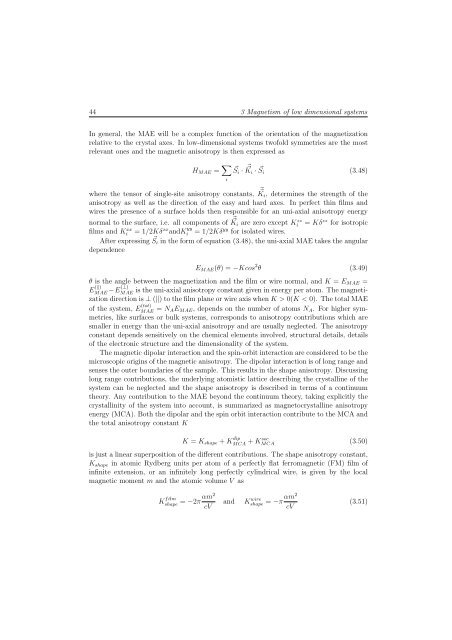Ab initio investigations of magnetic properties of ultrathin transition ...
Ab initio investigations of magnetic properties of ultrathin transition ...
Ab initio investigations of magnetic properties of ultrathin transition ...
You also want an ePaper? Increase the reach of your titles
YUMPU automatically turns print PDFs into web optimized ePapers that Google loves.
44 3 Magnetism <strong>of</strong> low dimensional systems<br />
In general, the MAE will be a complex function <strong>of</strong> the orientation <strong>of</strong> the magnetization<br />
relative to the crystal axes. In low-dimensional systems tw<strong>of</strong>old symmetries are the most<br />
relevant ones and the <strong>magnetic</strong> anisotropy is then expressed as<br />
HMAE = �<br />
�Si · � Ki<br />
� · � Si<br />
(3.48)<br />
i<br />
where the tensor <strong>of</strong> single-site anisotropy constants, � � Ki, determines the strength <strong>of</strong> the<br />
anisotropy as well as the direction <strong>of</strong> the easy and hard axes. In perfect thin films and<br />
wires the presence <strong>of</strong> a surface holds then responsible for an uni-axial anisotropy energy<br />
normal to the surface, i.e. all components <strong>of</strong> � Ki<br />
� are zero except Kzz i = Kδzz for isotropic<br />
films and Kxx i =1/2KδxxandK yy<br />
i =1/2Kδyy for isolated wires.<br />
After expressing � Si in the form <strong>of</strong> equation (3.48), the uni-axial MAE takes the angular<br />
dependence<br />
EMAE(θ) =−Kcos 2 θ (3.49)<br />
θ is the angle between the magnetization and the film or wire normal, and K = EMAE =<br />
is the uni-axial anisotropy constant given in energy per atom. The magnetization<br />
direction is ⊥ (�) to the film plane or wire axis when K>0(K

















